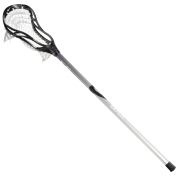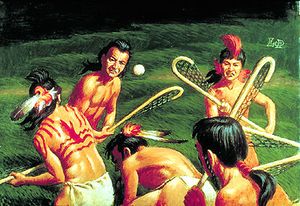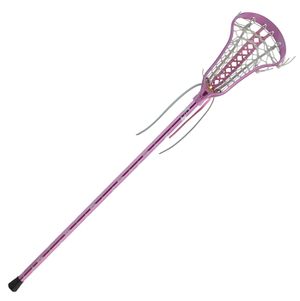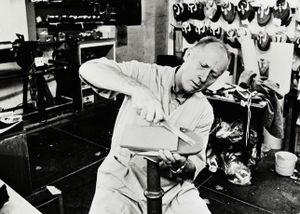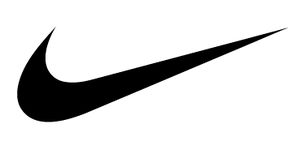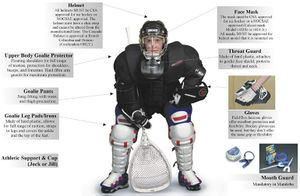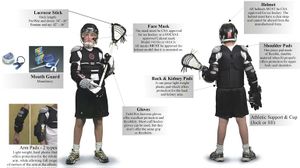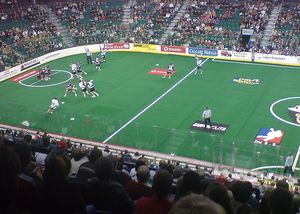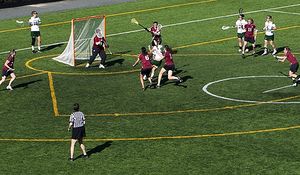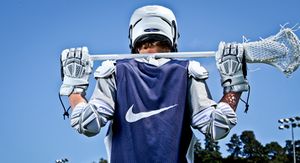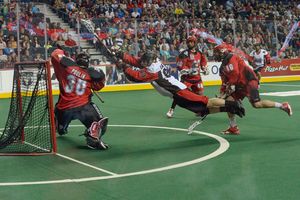Course:HIST104/ Nike Lacrosse Stick
| HIST 104 | |
|---|---|
| Section: | 99A |
| Instructor: | Joy Dixon |
| Brendan Wright | |
| Email: | |
| Office: | |
| Office Hours: | |
| Class Schedule: | |
| Classroom: | |
| Important Course Pages | |
| Syllabus | |
| Lecture Notes | |
| Assignments | |
| Course Discussion | |
| [[Category:]] | |
Early History of Lacrosse
Aboriginal History
Lacrosse is derived from ball games played by Aboriginal people.[1] It has strong connections with the Native games such as the Mohawk ball game of tewaarathon, Onondaga game called Deyhontsigwa’ehs, and a ball game referred as baggataway by various Algonquian language groups.[2] All three games are also known as ‘The Creator’s Game’. The First Nations believe that the game is sacred and it was given to them by the Creator and for the Creator’s amusement.[3] In the past, along with the purpose of fulfilling the Creator’s joy, the First Nations played the games to keep young warriors fit and powerful for hunting and war. They also played to fortify diplomatic alliances and support social issues.[4] Unlike today’s lacrosse games, Aboriginal women were excluded from the games. Instead, they served refreshments to the players assisting the medicine men who acted as coaches.[5]
Early Lacrosse Stick
The traditional lacrosse sticks are made out of wood. [6]A single piece of wood would be bent to form the head part of the stick. In the past, to make the process easier, the Indigenous stick makers often wrapped the trees with pliant and steamed hickory.[7]
There were two types of traditional lacrosse sticks: the ones with wooden enclosed pockets and the ones with enclosed pockets. The sticks with wooden enclosed pockets were often used in pairs because of its small size.[8] One stick would atop the other to catch the ball. They were more common in the southeast. A vertically running string intersecting with a string running horizontally made the sac of the stick.[9] A historical record says Cherokee-- one of the southeastern tribes--lacrosse stick was woven with deerskin.[10]
The sticks with unenclosed pockets were common in the northeast.[11] They were enclosed with string or rawhide weaving and had shallow pouches. [12] Over time, the pockets of the lacrosse became more rigid and the webbing became tighter. However, the sticks used in the women's field lacrosse team have a shallow pouch and is similar to the traditional lacrosse stick.[13]
Later History of Lacrosse
In the 1830’s Anglophones who were visiting the Saint Regis missionary noticed the Mohawks playing a strange ball game. The Anglophones later brought the game home as their new favourite past time and kept its name lacrosse. A decade later in 1844 the first ever recorded game of Lacrosse between the Anglophones and the Mohawks was played. Due to its ever growing popularity the Montreal Lacrosse Club was established and was later followed by the Hochelaga and Beaver Club in 1856. Four years after in 1860 the founding of the two lacrosse clubs the Prince of Wales, who was visiting Montreal, was shown two separate games of lacrosse. One of these was played between the Iroquois and the Algonquian people while the second was played between the Natives and non-Aboriginals. That same year a dentist by the name of William George Beers recorded all of the rules and regulations to lacrosse and changed the traditional deerskin ball to a rubber ball. Since then Beer has been known as the father of modern lacrosse. Over the next sixteen years lacrosse was successfully toured around England three times. The first tour in 1867 consisted of a team of sixteen players mostly of the Iroquois people although other tribes were represented as well. Lacrosse was played in front of Queen Victoria during the second tour of lacrosse in 1876[14]. The last tour was made in 1883 to Scotland[15]. While lacrosse was being toured in 1876 across England Beers was attempting to have lacrosse named as the national sport of Canada instead of cricket, which at the time was the national summer sport. By the beginning of the 20th century lacrosse had already gained popularity in many countries and was added into the Olympic games of 1904 and 1908[16].
The first ever women’s lacrosse team was allegedly formed in 1890 by an all-girls school in St. Andrews, Scotland. Over the next twenty-three years the changes were made to the teams include the addition of players from eight in 1890 to 12 by 1913. With the addition of players, positions were also altered and added to accommodate the new number of players on the team. In 1926 women’s lacrosse was introduced to the United States of America. As the century continued men’s lacrosse also changed with alterations to the positions on the field and simplifying them to goal keeper, attack, midfield, and defense[17]. By 1971 the International Federation of Women’s Lacrosse Association (IFWLA) was formed and three years later in 1974 the International Lacrosse Federation (ILF) for men was formed. In 2008 lacrosse was unified under all genders by the Federation of International Lacrosse (FIL).
History of Nike
Bill Bowerman
Bill Bowerman was born in Portland Oregon on February 19, 1911. Bowerman attended the University of Oregon and played on their football team. He eventually joined the military and served in Italy during World War II and retired having obtained the rank of Major. Bowerman became head coach of the track team at his alma matar, the University of Oregon. The University of Oregon team quickly rose to prominence under his leadership, having coach many athletes that became Olympians.[18]
Phil Knight
Phil Knight was born in Portland Oregon on February 24, 1938. Knight was a track athlete who was determined to create a better running shoe. He travelled to Japan and obtained the rights to sell ‘Tiger’ shoes in the western United States. [19]
Knight and Bowerman Meet
Phil Knight, seeking an endorsement, sent the shoes to Bill Bowerman. Bowerman appreciated the quality of the shoe and offered to partner with Knight. On January 25, 1964, the two men made an informal agreement to begin a partnership to start selling shoes under the name Blue Ribbon Sports. Knight, who held an MBA, focused on the business while Bowerman focused on design. After importing shoes from Japan to sell in the United States, Bowerman came up with a design for their own running shoe. One of Knight’s friends recommended calling their company Nike, named after the Winged Goddess of Victory in Greek mythology. The company’s name officially changed to Nike, Inc in 1971.[20]
Swoosh Logo
Nike paid Carolyn Davidson, a graphic design student at Portland State University $35 to create a logo for their newly created brand. Knight reluctantly settled on a swoosh logo that Davidson presented to him and the logo was first used on June 18,1971. Nike soon became the dominant athletic shoe maker in the American market. The company went public and started a series of successful advertising campaigns, furthering their success.[21]
Company Expansion
By the 1980s, Nike came to the conclusion that it was in their best interest to expand their product line by selling various types of sports equipments and to expand to international markets. Nike also acquired other companies and expanded their brand to urban and sports clothing. Nike has also recently ventured into the technology market by partnering with Apple to create Nike+. Today, Nike’s market capitalization is over $86 Billion.[22]
Introduction of Lacrosse Equipment
In 2000, Nike launched a lacrosse line which encompassed cleats, uniforms and apparel. In recent years, Nike has sponsored several American college lacrosse teams. In 2006, Nike partnered with the Iroquois Nationals Lacrosse Team in an effort to support fitness and wellness in Native American communities. Nike supports the Iroquois Nationals Lacrosse Team by providing them with Nike equipment and uniforms. In 2009, Nike began selling lacrosse heads, shafts, shoulder pads, arms pads and gloves. The official website for Nike Lacrosse states that “Nike Lacrosse has also taken great pride in its relationship and sponsorship of the Iroquois National Lacrosse Team and honors the game's roots through the Native American culture.”[23]
Nike's Entire Market
Variety of Sport Products and Geographical Market
Nike is sold worldwide and produces a wide range of sporting equipment. They don't have a specific sport that the company focuses on. In fact, they make products for many sports, such as track and field, baseball, ice hockey, tennis, soccer, lacrosse, basketball, cricket, football, tennis, golf, and even more. This massive company has even teamed with other worldwide incorporations to expand their market even more. For example, Apple Inc. These two teamed up to create equipment like shoes, watches and apps on our smart phones that are able to "keep track of your location, pace, distance, laps, and calories burned. With the Polar Wearlink+, it also tracks your heart rate. It stores all your run history and keeps tabs on your personal records."[9]
In 2014, "North American remains their biggest market, keeps momentum in footwear and apparel, with sales rose by 12% to little over $3.5 billion."[10] This brand is only continuing to grow as we can see by the picture of the chart. With the market continuing to grow in the likes of Japan, Western Europe, and China there is no doubt that there will be even more equipment coming out from this company.
Lacrosse's Top Markets
Lacrosse isn't a sport known too well around the world, however it still has its fair share of national following. Both types of lacrosse, whether it is field or box are very popular in countries like Canada, United States, Australia. There are a couple of hotspots that enjoy field lacrosse over box lacrosse and vice versa however. For example, in Europe, countries like Wales and Czech Republic have more of a following in field while the rest of the United Kingdom are taking more of an appeal to box lacrosse as of late. Nonetheless, Nike's top market for lacrosse equipment is without a doubt, Canada and the United States. With growing profits all over Australia and the U.K.
Lacrosse Today
Defining Lacrosse:
Lacrosse is a team sport played between two rival teams. It is split into two different versions: Box Lacrosse and Field Lacrosse. Box lacrosse is typically played in an arena with boards outlining your playing area, also known as indoor lacrosse, while field lacrosse is outside played on a field without any boards. Lacrosse is considered a full contact sport, therefore it can get rough and physical, this can often result in injuries. Lacrosse use's a small rubber white ball that you carry by holding a long handled stick known as a lacrosse stick. The head of the lacrosse stick is strung together with loose mesh that is designed to catch and hold the lacrosse ball. Players wear certain equipment In order to play such as shoulder pads, rib protectors, and helmets to prevent injuries, but this doesn’t fully protect your body from being harmed all the time.
Objectives:
Offensively, the goal is to work as a team to score goals by shooting the ball into the opponent’s goal. By using the lacrosse stick to catch, cradle, and pass the ball to work as a team and ultimately shoot the ball into the opposing net. Every time you score a goal your team earns one point. At the end of the sixty-minute game, whoever has the most point’s wins the game.
Defensively, the goal is to keep the other team from scoring and to gain re-possession of the ball through the use of the stick checking and body contact. The goalie is the last line of defense; they stand directly in front of the net defending the goal. The goalies wear larger and heavier equipment compared to players because the ball is thrown hard and they need to stay safe while filling up the net as much as possible in order to the keep the other team from scoring. The equipment goalies use are lacrosse sticks enabled with a bigger head to catch the ball, a chest protector, large plastic leg protectors, gloves, large pants and a helmet.
Leagues and Popularity
Lacrosse continues to grow and become more popular each year. Different levels of Lacrosse allow you to enjoy the game at a more competitive level or recreational level. Although Lacrosse originated in Canada, it has spread and now is popular throughout the world, but mainly in North America. College Lacrosse has become very popular in the United States; it has developed 88 National Collegiate Athletic Association (NCAA) division one men lacrosse teams, along with 91 division one women’s lacrosse teams. These teams include all the major universities throughout the United States. This allows players to pursue the game they love playing in these leagues, while achieving education status at the same time, ultimately overall becoming highly educated student athletes. [24]
The National Lacrosse League (NLL) is a professional lacrosse league played throughout North America. Currently it has nine teams with five in the United States and four in Canada. The NLL takes place during the winter and spring, and each year every team battles to win the Champion’s Cup. “The NLL has some of the best players in the world and has averaged between 9,400 and 10,700 fans per game”. [25] These numbers show how popular the sport has become building a popular fan base around all communities, while these numbers still only continue to grow.
- ↑ http://www.thecanadianencyclopedia.ca/en/article/lacrosse/
- ↑ http://www.cbc.ca/archives/entry/lacrosse-originally-an-old-indian-game-called-baggataway
- ↑ http://www.onondaganation.org/culture/sports/lacrosse/
- ↑ http://www.thecanadianencyclopedia.ca/en/article/lacrosse/
- ↑ Culin, Stewart. Games of the North American Indians (Dover Publications, 1907) 580, 607.
- ↑ http://jhepptest.library.jhu.edu/omeka/exhibits/show/161/explore-old
- ↑ http://www.thecanadianencyclopedia.ca/en/article/lacrosse-stick/
- ↑ Venum, Thomas. American Indian Lacrosse: Little Brother of War (Smithsonian Institution, 1994) 76
- ↑ http://www.thecanadianencyclopedia.ca/en/article/lacrosse-stick/
- ↑ Venum, Thomas. American Indian Lacrosse: Little Brother of War (Smithsonian Institution, 1994) 332
- ↑ Venum, Thomas. American Indian Lacrosse: Little Brother of War (Smithsonian Institution, 1994) 76
- ↑ http://www.thecanadianencyclopedia.ca/en/article/lacrosse-stick/
- ↑ http://www.thecanadianencyclopedia.ca/en/article/lacrosse-stick/
- ↑ http://www.thecanadianencyclopedia.ca/en/article/lacrosse/
- ↑ https://filacrosse.com/origin/
- ↑ https://filacrosse.com/origin/
- ↑ https://filacrosse.com/origin/
- ↑ Nike History
- ↑ Stanford Magazine
- ↑ Lemelson MIT
- ↑ Independent News UK
- ↑ Forbes
- ↑ Nike Lacrosse
- ↑ http://www.ncaa.com/sports/lacrosse-men/d1
- ↑ http://www.nll.com/view/nll
